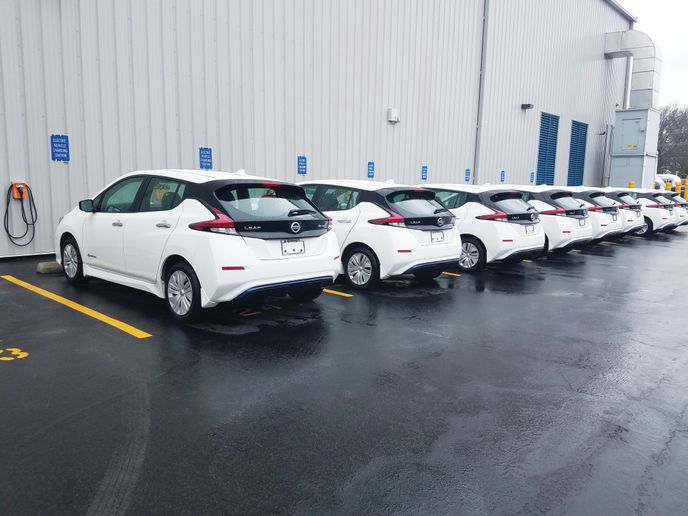On the passenger car side, which has a more developed product cycle, the hot sector is municipal and corporate motor pools.
When Amazon threw down the gauntlet with its commitment to 100,000 electric delivery trucks, the world started waking up to fleet electrification. While that deal — inked with EV startup Rivian — is still just on paper, the electrification of commercial vehicles had already been well underway.
“We’ve always thought this was the year of the electric fleet pilot. It is, but we’re starting to see some significant implementations as well,” says Michael Hughes, chief commercial and revenue officer at ChargePoint, an electric vehicle charging network company.
Hughes points to pilots in Classes 6 to 8 with high-profile fleets such as PepsiCo, FedEx, and UPS, and actual implementations in municipal bus transit agencies across the country. The market leaders in bus manufacturing — New Flyer and Gillig — are retooling their production pipeline toward electric, while new players such as BYD and Proterra make only electric buses.
On the passenger car side, which has a more developed product cycle, Hughes says the hot sector is municipal and corporate motor pools. He cites implementations in municipalities in California, the cradle of EV civilization in the U.S., but also cities such as Atlanta, Columbus, and New York City.
The duty cycles of a typical municipal motor pool aren’t complex, such as a staffer who takes a sedan for an inspection or a meeting across town. The cars come back to a central depot and charge overnight.
Moreover, cities are more conscious of air quality. “I can’t imagine being in a major urban area and not considering electric vehicles in 2020,” Hughes says.
Logistics fleets — particularly last mile — present the next big opportunity, which dwarfs all other markets by size. Yet this market is “orders of magnitude more complex,” considering payload, power requirements, route factors such as temperature and terrain, and the mission-critical nature of deliveries.
As electrification develops in the commercial vehicle market, fleets are faced with building out infrastructure that plans for growth with electric vehicles of various sizes and applications.
Managed, Distributed Charging
Most EV charging needs today are met by Level 2 (240-volt) charging. Electric vehicles need to convert the alternating current (AC) typically found in household outlets to the direct current (DC) needed for the EV battery. This happens through the EV’s onboard charger.
For many fleet applications, today and in the future, Level 2 charging will be sufficient. “We have seen very few use cases in which dwell times aren’t long enough to support getting a full charge for the next day’s route,” Hughes says.
Hughes points to PepsiCo, which has 70,000 trucks delivering both heavier weight liquids and lightweight snacks. About 84% of those vehicles run fewer than 100 miles per day and are domiciled for 13 hours overnight.
Level 3 DC fast chargers, however, make this conversion within the charging station itself to deliver DC power directly to the battery, which is why they charge faster — to 80% capacity in approximately 30 to 60 minutes for most EVs available today.
Down the road, fleets with larger vehicles, such as over-the-road big rigs, and longer routes will have to plan for the incorporation of DC fast charging. Yet most fleets starting the process right now shouldn’t have to worry about building DC fast charging infrastructure out of the gate.
They do, however, need to plan for a distributed charging network, in which a central hub distributes power to multiple smart dispensers at various locations that are independently controlled and managed.
Early electric pilots made the mistake of unmanaged charging where vehicles would return to the depot and plug into a self-contained charger that was subject to the utility rate at that moment. “It just doesn’t make sense long term to have a completely independent set of manageable endpoints,” Hughes says.
Managed charging requires inputs and algorithms that consider vehicle type, battery size, current state of charge, utility rates, and required range — all in relation to the rest of the fleet needing to be charged. Done effectively, charging costs can be greatly reduced.
DC fast charging infrastructure is, at this point, a lot more expensive than Level 2 charging. But the cost of a distributed charging system will be more manageable than three separate fast chargers.
The power conversion behind the fence “will cost a bit,” Hughes says, but the dispensers themselves won’t. And the managed controlling of utility rates will lower costs further.
Learning Curve
Hughes stresses that at the onset of the process fleet operators are surprised at how long it takes and how much there is to learn, particularly when dealing with utilities. “The ones who get in late won’t have gone through those lessons,” he says.
This is even more critical for fleets operating in cities such as New York, San Francisco, and Los Angeles that are considering various forms of carbon emissions restrictions. “They have to get in the game, otherwise they’re going to be left behind,” he says.
Fleets need to view electrification through software and controlling the distribution of power. This then expands into route management using telematics data and other data sources such as weather and topography.
“Everyone comes into fleet electrification talking about hardware,” Hughes says. “And they leave talking about software workflow and project management.”
by Chris Brown
Source: https://www.automotive-fleet.com
CUT COTS OF THE FLEET WITH OUR AUDIT PROGRAM
The audit is a key tool to know the overall status and provide the analysis, the assessment, the advice, the suggestions and the actions to take in order to cut costs and increase the efficiency and efficacy of the fleet. We propose the following fleet management audit.




